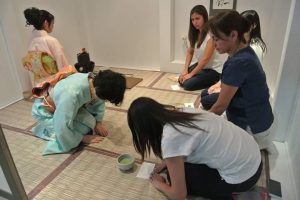Avez-vous déjà entendu parler de l’omotenashi ou de l’hospitalité omotenashi?
Ce terme décrit une profonde hospitalité qu’on voit souvent dans les hébergements, les cérémonies, les magasins, les restaurants, etc.
« Omote » signifie la face publique ou l’image qu’on cherche à montrer aux autres, et « nashi » signifie « rien ». Ensemble, ces deux termes dénotent une hospitalité offerte du fond du cœur sans dissimulation ou prétention.
Pour mieux comprendre où se situe l’omotenashi, regardons l’échelle de l’hospitalité.
Tout au bas de la pyramide se trouve la morale, des comportements standards que la société juge bons ou mauvais. L’hospitalité à ce niveau est très faible.
Ensuite viennent les manières, les standards du bon comportement dans la société.
Puis vient le service, un standard de bon comportement dont on peut bénéficier moyennant une contrepartie monétaire.
Sur l’avant-dernier palier se trouve l’hospitalité, un traitement ou accueil généreux souvent offert en s’attendant à quelque chose en retour.
Au sommet de la pyramide, c’est l’omotenashi, un comportement généreux sans aucune attente de retour.
C’est l’une des bases de la cérémonie du thé avec l’ichigo ichie, l’idée que chaque rencontre avec un convive est un moment unique qui doit être honoré. L’hôte veut faire en sorte que l’invité se sente aussi important et bienvenu que possible sans s’attendre à aucune récompense.
La cérémonie du thé comprend véritablement toutes les facettes de la culture japonaise!
Savez-vous quels autres concepts sont à la base de la cérémonie du thé? Nous en discuterons davantage dans les prochains blogs!
*******************************************************************************
Have you ever heard of omotenashi or omotenashi hospitality?
This term describes a profound hospitality that is offered in home stays, ceremonies, retail, dining and many other places.
“Omote” means public face or the image one wishes to present to the public, and “nashi” means nothing. Together, these words mean hospitality offered from the heart without hiding or pretense.
The following scale of hospitality will help show exactly where omotenashi is located.
At the bottom of the pyramid lie morals, standards or behaviours which society determines to be right or wrong. The sense of hospitality on this tier is very low.
Then come manners, the basic standards of good behaviour in society.
Next is service, a standard of good behaviour you get in exchange for monetary compensation.
Second from the top comes hospitality, which is generous treatment or welcome often given with the expectation of something in return.
At the very top of this pyramid lies omotenashi, which is generous behaviour offered without expectation of return.
It is one of the foundations of tea ceremony along with ichigo ichie, the idea that each meeting with a guest is a once in a lifetime experience, and every moment should be honoured. The host makes the guest feel as important and welcome as possible, while expecting nothing in return
Tea ceremony truly encompasses every aspect of Japanese culture!
What else do you think lies at the heart of tea ceremony? We’ll find out in the next few blog posts!


